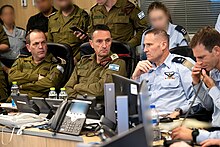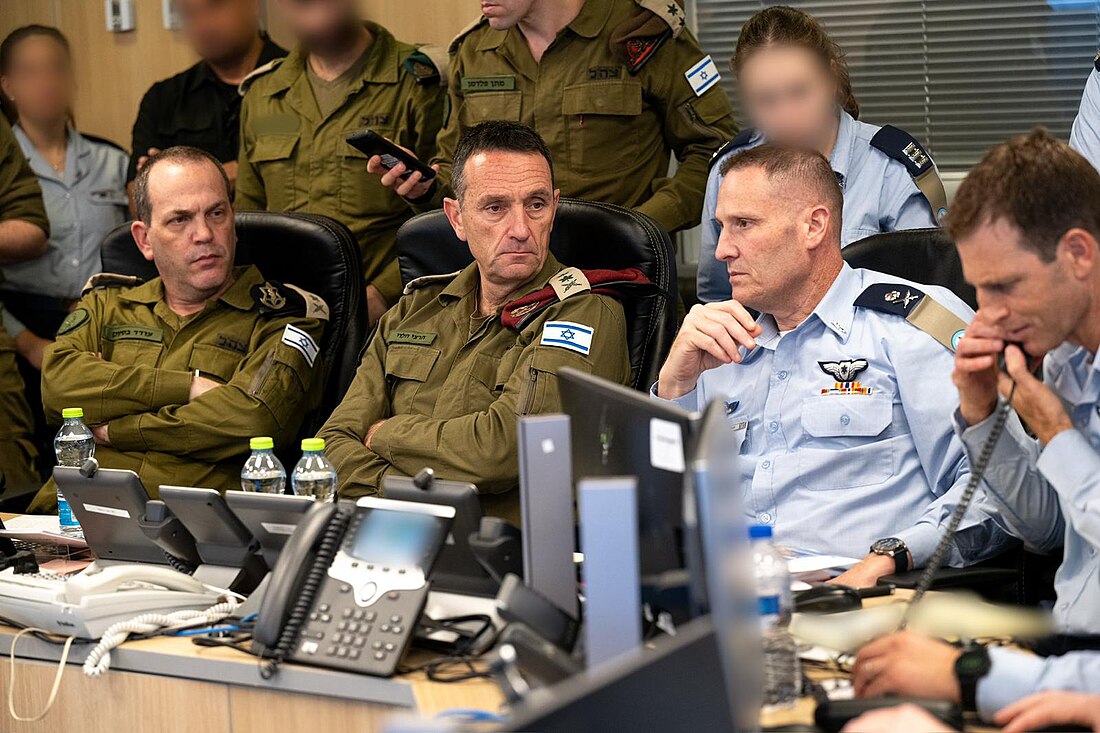In 2024, the Iran–Israel proxy conflict escalated to a brief period of direct confrontation between the two countries. On 1 April, Israel bombed an Iranian consulate complex in Damascus, Syria, killing multiple senior Iranian officials.[32] In response, Iran and its proxies seized the Israeli-linked ship MSC Aries and launched strikes inside Israel on 13 April.[2][33] Israel then carried out retaliatory strikes in Iran and Syria on 19 April.[34][35]
| 2024 Iran–Israel conflict | |||||||
|---|---|---|---|---|---|---|---|
| Part of the Iran–Israel proxy conflict and the spillover of the Israel–Hamas war | |||||||
 IDF meeting during Iranian strikes on Israel | |||||||
| |||||||
| Belligerents | |||||||
|
Supported by: |
Supported by: Intelligence: | ||||||
| Commanders and leaders | |||||||
| |||||||
| Units involved | |||||||
|
|
| ||||||
| Casualties and losses | |||||||
|
| ||||||
| |||||||
The Israeli strikes were limited, and analysts say they signaled a desire to de-escalate. Iran did not respond to the attack, and tensions de-escalated back down to the proxy conflict.[36]
Other actors participated in the conflict as well. The United States, United Kingdom, France, and Jordan intercepted Iranian drones to defend Israel.[30] Syria shot down some Israeli interceptors, and Iranian proxies in the region also attacked Israel.[1][2]
Tensions increased after the assassination on 31 July of Ismail Haniyeh, the political leader of Hamas,[37] which occurred a few hours after the 2024 Haret Hreik airstrike that assassinated Hezbollah commander Fuad Shukr. Iran and Hezbollah pledged retaliation.[38]
Background
After the Iranian Revolution in 1979, Iran took a more critical stance on Israel,[39] and a proxy war emerged as Iran supported Lebanese Shia and Palestinian militants during the 1982 Lebanon War.[40] Iran began to gain power and influence with other countries and groups.[41] The conflict evolved with Israeli attempts to stop the Iranian nuclear program and confrontations during the Syrian civil war.[42][43]
Tensions during the Israel–Hamas war
On 7 October 2023, Hamas, a Palestinian militant group partially funded by Iran, launched an attack on Israel resulting in the deaths of almost 1,200 Israelis, mostly civilians, and the outbreak of the Israel–Hamas war.[44] Israel also skirmished with Iranian proxy Hezbollah in Lebanon.[45] After the attack, Israel began targeting Iranian and proxy troops in Syria more frequently as retaliation.[46] Fears of a regional war grew in the following months.[47]
On 25 December, Razi Mousavi, an Iranian commander, was killed in a targeted Israeli airstrike at his residence in Sayyidah Zaynab, 10 km (6 mi) south of Damascus, amid the Israel–Hamas war. Mousavi's assassination marked the highest-ranking killing of a senior Iranian military official since the targeted assassination of Qasem Soleimani, until the subsequent killing of Mohammad Reza Zahedi in 2024.[48][49]
On 20 January 2024, Sadegh Omidzadeh, along with four other Iranian officials, Ali Aghazadeh, Saeed Karimi, Hossein Mohammadi,[50] and Mohammad Amin Samadi,[51] was killed during a meeting at a building in the Mezzeh district of Damascus. The Israeli airstrikes, as reported by the Syrian Observatory for Human Rights, resulted in the complete destruction of the building, leading to the death of at least 10 military personnel.[52]
Timeline
April 2024 escalation
Israeli bombing of Iranian embassy (1 April)
On 1 April, Israel bombed the Iranian embassy in Damascus, Syria. The attack killed 16 people, including multiple Iranian officers and proxy fighters. Most notably, Mohammad Reza Zahedi, a commander for the Quds Force was killed in the airstrike.[16] Iranian officials in the building were allegedly meeting with Palestinian militant leaders at the time of the attack.[53]
Israeli preparations (2–12 April)
Iran vowed to respond, and Western sources suspected it would attack directly inside Israel.[54] Israel began preparing in the days leading up to the attack, evacuating Israeli embassies and jamming GPS signals in the case of an aerial bombing.[55][56] France deployed its navy to defend Israel.[8] Saudi Arabia and the United Arab Emirates provided Israel with intelligence on the strikes.[10]
Seizure of the MSC Aries (13 April)
On 13 April 2024, the IRGC Navy took control of the Portuguese-registered and Madeira-flagged container ship MSC Aries in the Hormuz Strait where it was boarded by Iranian commandos in international waters off the coast of UAE via helicopter,[57][58] then directed to Iranian territory for "violating maritime law". The ship is leased to MSC by Gortal Shipping, an affiliate of Zodiac Maritime, whose principal is Israeli.[59] Following the incident, Israel called on the European Union to sanction the IRGC.[60]
Iranian strikes on Israel (13–14 April)
Early on 13 April, Hezbollah attacked southern Israel with around 40 rockets. Israel responded by bombing a Hezbollah weapons manufacturing site in Lebanon.[61] Al Jazeera said the attack was significant given the conflict.[62]
Later, Iran and its proxies attacked Israel with about 300 drones and multiple ballistic missiles.[33] The Houthis, Islamic Resistance in Iraq, Badr Organization, and True Promise Corps also launched attacks on Israel under Iranian command.[6][2][4] Syria shot down some Israeli intercepters.[1] The United States, United Kingdom, and Jordan intercepted over 100 Iranian drones.[7][9] The drones and missiles eventually hit various cities across Israel, the West Bank, and Golan Heights.[63] The attack also damaged the Nevatim and Ramon airbases.[64] 33 civilians were injured.[65][66][67]
Heightened tensions (14–18 April)
Israeli and U.S. officials conducted situational assessments that night. The United States said it would not participate in a retaliatory strike on Iran. Iran threatened that if Israel were to retaliate, directly or indirectly, it would strike back harder.[63] Israel said the attack warranted a response.[67] The United States warned Israel to exercise restraint, and the Israeli war cabinet argued over the scale of Israel's response.[68] Israel delayed plans to start an offensive in Rafah that week so it could determine a response.[69]
The war cabinet continued arguments over the Israeli response during the following week. The cabinet considered military and diplomatic options, with international pressure to de-escalate the situation influencing decisions.[70] On 18 April, it was reported that the United States would greenlight a Rafah offensive in exchange for no Israeli strike on Iran.[71] The U.S. and EU tightened sanctions on Iran.[72]
Israeli response (19 April)
On the morning of 19 April, Israel retaliated against Iran. Israel attacked three targets in or near Isfahan International Airport, including a military base. One of the targets was a radar for the Natanz nuclear site. Iran claimed that its air defense shot down all Israeli projectiles and that the explosions were from air defense, but satellite images showed a damaged air defense battery and damage to the radar system.[73][74] Israel did not comment or claim responsibility for any attack. In southern Syria, SAA bases were targeted, leading to material losses.[75] Explosions and fighter jets were also heard in Iraq,[76] and debris from an Israeli missile was found in central Iraq, suggesting Israel fired from there.[77]
De-escalation period (April–July)
Iranian state media downplayed the limited Israeli strike and Iranian officials said there was no planned retaliation against Israel.[78] An anonymous source told CNN that direct state-to-state strikes were over.[79] Analysts said the attack and Iranian reaction showed that both sides want to de-escalate, but that Israel could potentially inflict more damage in a full-scale war.[36]
Summer 2024 escalation
Assassination of Ismail Haniyeh (31 July)
On 31 July 2024, Ismail Haniyeh, the political leader of Hamas, was assassinated along with his personal bodyguard in the Iranian capital Tehran by an apparent Israeli attack.[37] Haniyeh was killed in his accommodation in a military-run guesthouse after attending the inauguration ceremony for Iranian president Masoud Pezeshkian.[80] The assassination took place a few hours after the Israeli bombing of Beirut which assassinated Hezbollah commander Fuad Shukr, killed an IRGC member and killed five civilians.
Heightened tensions (August)
In response to the assassination of Ismail Haniyeh and the Israeli bombing of Beirut that assassinated Fuad Shukr, Iran and Hezbollah pledged retaliation.[81][82][38] According to Israeli reports, retaliatory attacks are likely to be launched by multiple members of the Axis of Resistance, including in Lebanon, Gaza, Iraq, Syria and Yemen, as similarly done in the coordinated attack on Israel in April 2024.[83] Many countries warned their citizens to leave Lebanon because of increasing war tensions.[84][85]
The U.S. State Department has been trying to prevent an attack by working through diplomats to send the message to Iran that escalation of the conflict is not in their best interests, and that the U.S. will defend Israel from attacks. Other U.S. officials stated that the successful shoot-down in April relied on good military intelligence about what Iran was planning, but this time the military situation is more uncertain.[38] Russian President Vladimir Putin sent a message to Iran's Supreme leader Ayatollah Ali Khamenei through Sergei Shoigu, the secretary of Russia's security council, to have a restrained response, and not to attack Israeli civilians.[86]
The United States military announced the deployment of an additional squadron of F-22 Raptors from the 1st Operations Group of the 1st Fighter Wing;[87] 4,000 marines and 12 ships were deployed to the region[lower-alpha 2] as a part of Carrier Strike Group 9 in the Persian Gulf and three Wasp-class amphibious assault ships,[lower-alpha 3] two destroyers[lower-alpha 4] and the 26th Marine Expeditionary Unit as a part of the USS Wasp amphibious ready group in the eastern Mediterranean Sea.[89][90] The Carrier Strike Group 3 including USS Abraham Lincoln (CVN-72) and an unspecified number of cruisers and destroyers along with Carrier Air Wing Nine was also deployed, sent from the Pacific Ocean.[87]
On 5 August 2024, NOTAMs were issued to warn pilots regarding the closure or restriction of the airspace of Iran[91] and Jordan,[92] a precaution related to a possible attack by Iran against Israel.
Notes
- (including the USS Wasp (LHD-1), USS New York (LPD-21) and a third ship[88])
References
Wikiwand in your browser!
Seamless Wikipedia browsing. On steroids.
Every time you click a link to Wikipedia, Wiktionary or Wikiquote in your browser's search results, it will show the modern Wikiwand interface.
Wikiwand extension is a five stars, simple, with minimum permission required to keep your browsing private, safe and transparent.
